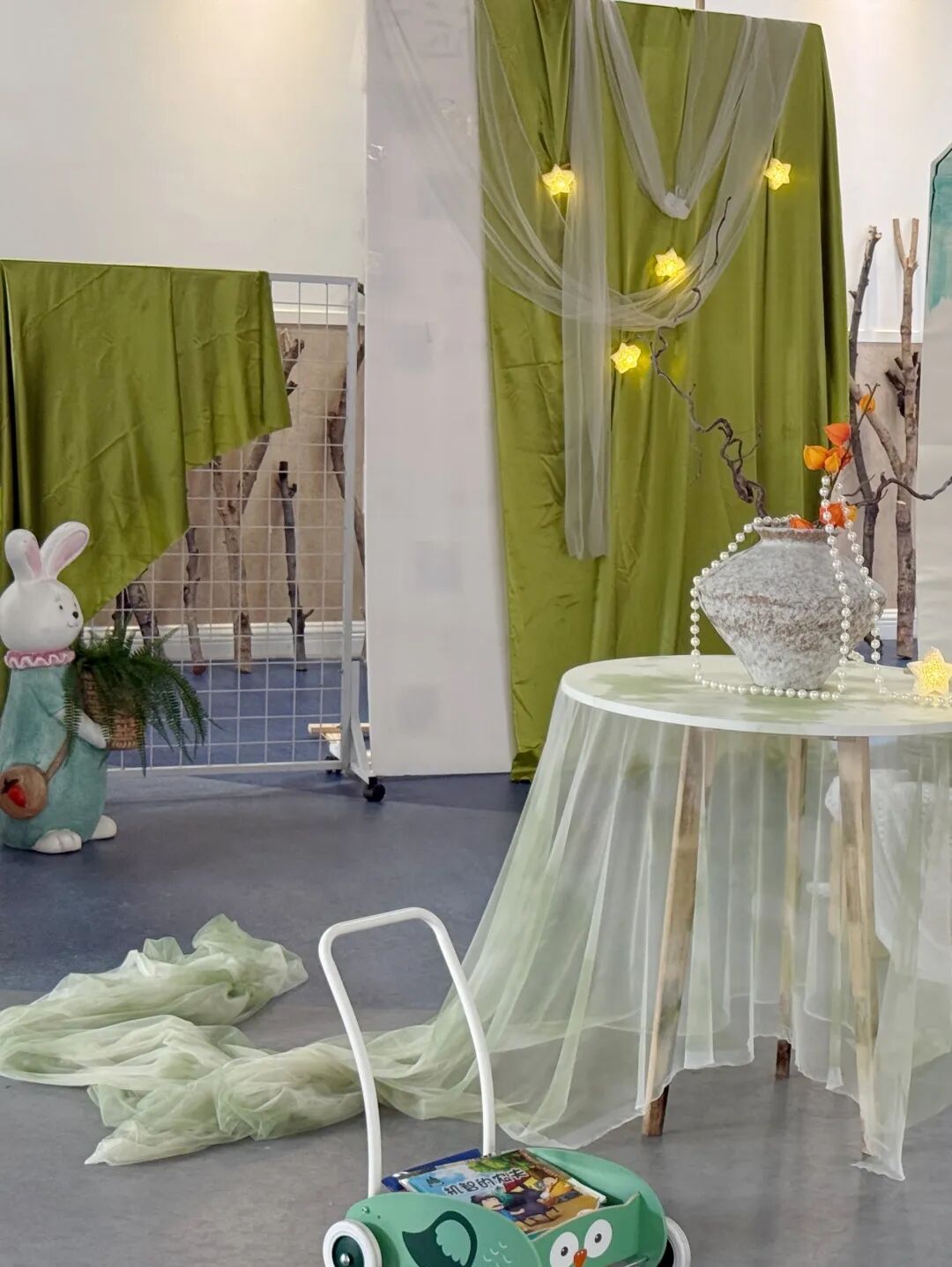王老师微信:18610206462
王老师18610206462
中班语言教案:小熊长大了1
活动目标:
1、通过欣赏故事,理解什么是长大,体验成长的快乐。
2、学说小动物们的话,能用动作、表情表达他们成长的喜悦心情。
活动准备:
故事PPT、音乐、动物图片
活动过程:
一、什么是长大。
谈话:孩子们,你们知道什么是长大吗?有哪些变化?小结:长大真是一件开心的事情。
二、小动物们长大了吗?
1、观看PPT,欣赏故事第1—5段。
今天森林里特别热闹,小动物们在讨论自己是不是长大了,孩子们,你们想知道答案吗?
提问:孩子们,故事发生在什么时候?(暑假过去的一天早晨)小熊在干什么?小熊的朋友们都来了,他们说了什么?做了什么?他们长大了吗?
2、出示动物图片,学说小动物们的语言。
小马是怎么说怎么做的?他的心情怎么样?(有表情地复述小马的话,并加上一定的动作)
小兔是怎么说怎么做的?(复述并做动作)
小象呢?它是怎么说的?又是怎么做的?(要求同上)
3、体验小熊的心情。
提问:小熊做了一个什么动作?说了什么?(就是我没长大,好像还和原来一样)小熊的心情怎么样?是啊,大家都长大了,小熊以为就自己没长大,又难过又伤心。
三、感受小熊的变化,理解什么是长大。
1、观看PPT,欣赏故事第6段至结束。
小熊到底有没有长大呢?我们继续来听故事。
提问:小熊穿衣服的时候发生了什么事情?穿鞋子的时候又发生了什么事情?小熊对大家说,原来的衣服、鞋子怎么变小了,真的是变小了吗?那是为什么?小熊是在什么情况下发现自己长大了呢?小熊长大了吗?小结:原来在不知不觉中小熊已经长大了,它的衣服、鞋子、帽子都变小了,连原来跳不过去的小河也能轻而易举地跳过了,小动物们是幼儿园中最大的孩子了。
2、讨论:你长大了吗?体验成长的快乐。
①孩子们,你们觉得自己长大了吗?你是从哪些方面知道自己长大了呢?(长高、有力气、跑得更快)
②除了身体的变化,还有哪些以前做不到但现在做得很好的事呢?(洗碗、擦地板、分毛巾、打饭……)
③长大的你们学会了这么多本领,能帮助别人做这么多的事,你的心情怎么样?(高兴、自豪)小结:是啊,长大了变得越来越能干,这种感觉真好。希望在以后的日子里你们都能继续做一个善良、乐于助人的好孩子。
四、完整欣赏故事,学习讲述故事。
1、再次欣赏故事。
孩子们,这个故事好听吗?接下来我们完整地来听一遍故事,等会请你来表演小动物的对话哦。
2、幼儿分四组进行角色表演。
现在请你们选择自己喜欢的角色站好,要把小动物的表情和动作都表现出来,看谁表演的最像。
3、教师总结小动物现在和你们一样都是幼儿园里最大的小朋友了,他们的心情和你们一样高兴、自豪。
活动反思与意见
纲要指出:语言能力是在运用的过程中发展起来的,发展幼儿语言的`关键是创设一个能使他们想说、敢说、喜欢说、有机会说并能得到积极应答的环境。故事中角色较多,每个角色都非常可爱,幼儿很是喜欢,每个角色都又有自己的特点和本领,幼儿能够根据特点进行扮演,同时学说对话。在幼儿自由选择角色的时候,我给孩子自由寻找同伴的机会,幼儿更具有自主权,可以培养孩子的合作精神。幼儿的自由表演既锻炼了语言表达能力,又体验了故事的内涵,同时也发展了孩子的表演技能。教师参与其中,与幼儿建立了平等的师幼关系,孩子在教师的旁白引导下,角色的扮演更有劲,胆量也更大。故事内涵也就在此其中自然而然渗透,幼儿感受到了小动物成长的喜悦心情。在让他们说一说自己有没有长大的时候,幼儿的兴趣很高,都说了自己的成长故事,幼儿在参与活动的过程中体验到长大了,有一种自豪感,,这样不仅让幼儿分享快乐,达到生生互动,还提高了幼儿的语言表达能力。
我想在这个活动还可进行延伸,让孩子知道不仅小动物会长大、会变化,在我们的自然界中,有很多的东西、有很多有生命的物体也都在长大、变化,进一步感知不同的物体长大变化过程。
Stude
A
P
1.复习歌曲“Good morning to you.”
T: good morning, boys and girls. Let’s sing the song “good morningto you”, Ok?
C: Ok.
2.学习banana和orange.
T
一.Greeting
Hello ,how are you ?
What ‘s the weather like today ?
What the day is today ?
二.Warming
《The sun》、《The moon》
三.新授
1. Gue
What’s in the bag ?
It’s ……
They are ……
2.One by one
3. 示范
(1)老师示范:let me try them on.
1. They are tight . They are not my size.
2. They are just right. They are my size.
(2) 幼儿示范:
T:how do you feel?
S:They are tight . They are not my size
They are just right. They are my size.
4. Game
幼儿围成圈,把自己的鞋子脱下来放在面前,听音乐,听老师指令。
Do you want to try?
Ok ,take off your shoes
Stand up.
听音乐,幼儿围圈走,音乐停,拿起面前的鞋子穿上。
How do you feel?
: Look! I have a beautiful basket. There are some fruits in it!
Look, that’s…
C: 香蕉
T: Yes, This is a banana.
请幼儿跟读
T:(尝一口)Banana is sweet. Follow me. Banana is sweet. Do you like toeat banana?
C: Yes.
T: If you want to eat banana, Let’s sing the song “I like banana.”Ok?
C: Ok.
T: Ok, very good!
Act:
Monkey: Mrs. Gao, Miss Gao.
T: Let’s have a look, what’s coming?
C: Monkey.
T: Monkey, Yes!
M: I want to eat…(着急说不出来)
T: Oh, The Little monkey wants to eat the banana, but she can’tspeak English.
Can you say it in English? Let’s tell her together, Ok? Ok, what’sthis?
请幼儿一起说:This is a banana
T: Yes, Monkey. Banana, Do you know?
M: Yes, I know.
T: If you want to eat the banana, you’ll say it in English oncemore. I’ll give
it to you, ok?
M: Ok! I want to eat the banana.
T: Ok, here you are. Bye.
M: Bye, Thank you
T: You’re so great to help the monkey to solve the problem. Now I’llintroduce agood friend to you.
QiQi (手偶琪琪): Good morning children. Today I bring you a kind offruit, I’ll giveit to you, but I want to tell you it’s English name before I give itto you. ButI can’t speak English.
T: It doesn’t matter, Now, I’ll teach you the word. Then let’s teach Qi Qitogether, Ok?
C: Ok.
T: Orange, orange, orange is sweet.
What do you like? Do you like to eat orange?
Please say it to your friends beside you.
请小朋友之间相互说:“I Like orange. This is an orange.
T: Now, Do you know what this is? What’s this?
C: Orange.
T: Ok, Let’s tell QiQi together. This is an orange.
Qi: I know I know. This is an orange. It’s for you.
C: Thank you, Qi Qi.
Qi: You are welcome
T: Let’s play a game, I’ll ask one of you to touch in my basket.
Then you’ll
tell the other friends. What have you touched. Ok?
C: Ok.
T: What’s this?
C: Apple (orange, pear, banana).
T: Oh, The fruits are sweet. Do you want to eat?
C: Yes.
T: Ok, Let’s sing the song “I like fruits”, Ok?
C: Ok.
T: Ok, before eating the fruit you must say: “I like…”, understand?
C: Yes.
T: Ok, come here.
roperties: Recorder, Overhead Projector and a map of world.
Teaching Objectives:
1. Practise listening ability.
2. Revise the grammar: the Comparative Degrees of Adjective and Adverbs
The Past Perfect Tense
Language Focus: Checkpoint 18
Teaching Procedures:
I. Showing the teaching aims
II. Revision
Check homework, then ask the students to read the partners’ homework to share with each other.
Revise the use of the Infinitive
III. leading in
T: Today we’ll learn something about Coco. Do you know where she is from?
IV. Listening practice
Play the tape or for the students to listen and find the answer, then look at the workbook, Exercise 1, go through the questions with the students and make sure they can understand what they mean. Play the tape again, let the students discuss their answers in pains before the teacher checks the answers with the whole class.
V. Presentation
Show the students a map of the world, and ask: What map is it? Help the students find “China” and “India” on the map. Let the students discuss the two countries: They are developing countries. They have a large population in the world.
Ask: What’s the population of China and what’s the population of India? Let the students read Part 2 and answer the questions. (China’s population is 1 328 000 000 and India’s population is 1 000 000 000). That’s to say India’s population is smaller than China’s .Ask the students to use the words in the box to complete the passage, then read together, finally ask the students to retell the text.
VI. Practice
Revise the Grammar: The Past Perfect Tense, give some examples:
1. He had left before his wife came back.
2. I remembered that Peter had already got a bike.
3. By the end of last month, he had learned 2000 new words.
4. When I got to the cinema, the film had begun.
Then ask the students to do Exercise 3. The answers are: 1 C 2 E 3 A 4 B 5 D. Let the students read these sentences together.
VII. Practice
Ask the students to do Exercise 4 first, then check the answers. The answers are: had, in, is, more, the, had, to, in, had, that, to, us, and, to
VIII. Workbook
Give the students five minutes to finish workbook. Do Exercises 1, 3 and 4. Then check the answers.
The answers to Exercise 1 are: took, went, found, was, called, told, had happened, said, would go, came, was found, checked, founded, said, stole, went, enjoyed, came, found, had stolen, had
The answers to Exercise 3 are: I worn out 2 try on 3 slow down 4 made up my mind 5 am pleased with 6 were angry with, deserve to 7 at least 8 as if 9 carried on
IX. Summary
Exercises in class
Fill in the blanks according to the text in this unit.
Lucy and Lily are___1___. They are living together___2___. But sometimes they fight. It doesn’t last too___3___. They___4___very well with each other again.
They look___5__, so it’s hard for people to recognize them: Who is Lucy___6__Lily. We always___7___mistakes. They feel___8__. They like most of the same things, for example: music, food and___9__. But Lily likes to___10__, Lucy likes to___11__, they don’t like the same colour,____12___. So they have some___13____Sometimes they disagree, but they never___14__. They love each other and they are___15___happy that they are twins.
Answers: 1.twins 2.most of the time 3.long 4.get on 5.the same 6.or 7.make 8. the same 9. books 10 .dance 11. sing 12. either 13. differences 14. fight 15.both
X. Homework
Prepare for the final examination.
Lesson 70 教学设计方案
Properties: Computer, Projector, PPT document provided.
Teaching Objectives:
1. Let the students understand the dialogue and learn new words.
2. Go over the Past Perfect Tense.
Language Focus:
New words: British, fail, summit, misty, mist
Useful expressions: disappear into, the first men to do tins, try to reach the top of
Teaching Procedures:
I. Showing the teaching aims
II. Revision
Ask the students to act out the dialogue is provided in Lesson 69-1.asf
III. Lead in
Give the students some information and pictures about Mount Qomolangma, and check their homework. Let them speak something about the history of climbing the Mount Qomolangma.
For example:
It was formed 60million years ago and ascends to the height of 8850. Surveyor General Andrew Waugh proposed to name the mountain Everest after his predecessor, George Everest. This name prevailed until today, although the mountain has two local names – Qomolangma in Tibetan, Sagarmatha in Nepali.
IV. Watch and listen
Ask the students to watch the flash Because it is there.swf which is provided. Listen the text carefully, and finish the questions:
True or False
1. Mount Qomolangma is the tallest mountain in the world. ( )
2. George Mallory is a professional (职业的) mountain climber. ( )
3. Mallory had tried four times to reach the top of the mountain. ( )
4. In 1921 he tried to climb the mountain for the first time. ( )
5. Edmund Hillary and Tenzing Norgay were thought to be the first men to reach the top of the mountain. ( )
6. Edmund Hillary found Mallory’s body in 1999. ( )
Answers:
1. √ 2. × 3. × 4. √ 5. √ 6. ×
V. Read the text
Let the students read the text carefully and grasp the main idea of this article. And find out what happened in different years (1921, 1922, 1924, 1953, 1999).
nne’s Best Friend Do you want a friend whom you could tell everything to, like your deepest feelings and thoughts? Or are you afraid that your friend would laugh at you, or would not understand what you are going through? Anne Frank wanted the first kind, so she made her diary her be
2.Banana apple cake biscuit cake fish box
3.bag book pencil-box pencil
4.cat (头饰)
过程:
一.出示小猫头饰,引起兴趣。
1. Good morning boys and girls.(Good morning.)
2. Who am I ? (cat)
3. Yes, I am a cat !And I am a hungry cat!
4. I want to eat some fish .
二.寻找小鱼,激发幼儿的积极性。
1. Where is it ?
Is it on the table ? (No, it isn’t.)
What is it ?(It is an apple.)
2. Is it under the table?(No, it isn’t.)
What is it ? (It is a banana.)
3. Is it beside chair?(No, it isn’t.)
What is it ? (It is a cake.)
4. Is it behind chair? (No, it isn’t.)
What is it ? (It is a biscuit.)
5. Where is it ?
Is it on the paino?
Oh, here’s a box on the paino.
Let me take a look.
6. Who can find it ? Please. Anyone?
7. Oh,it is in this box.
8.Oh,it’s time to go to school.
三.转换场景
1. Where is my bag?
2. Who wants to help me?
(It is behind the chair.)
3. Wher is my book?(It is under the chair.)
4.Where is my pencil-box?(It is on the table.)
5.Where is my pencil?(It is in the pencil-box.)
6.What a silly cat!!
7.Thank you ,Thank you ,Thank you very much!
四.游戏,提高幼儿的学习兴趣。
1. Now ,let’s play a game.
2. Who wants to try ?
3. Listen, we are have fuor tables.And a pencil for each of table.
4. Are you ready?(Yes ,sir.)
5. Ok.follow the instraaction.
Put it on the chair……You last(the game)You are winner(the game)
6.Who wants to be a teacher?Please.
7.Once again.
Game《go go go》
1. Last ,let’s play a game with your father and mother.
2. stand up (找自己的爸爸和妈妈)
3. Are you ready?(Yes,sir.)
4. Ok, game begain.
(1) go go go ,go go go ,stop.
(2) Stand beside the window.
(3) Stand behind the chair.
(4) Stanf on the chair…………..
五.结束
1. Last,Let’s say a rhyme..
2. Are you ready?(Yes ,sir.)
3. Listen to the music.
4. Left left right right ,go ,turn a round ,go go go.
On on on the headIn in in the handBehind behind behind the backUnder under under the chair.
5.Ok ,so much for today.Bye bye.
st friend. Anne lived in Amsterdam in the Netherlands during World War Ⅱ. Her family was Jewish so nearly twenty-five months before they were discovered. During that time the only true friend was her diary.
She said, ”I don’t want to set down a series of facts in a diary as most people do, but I want this diary itself to be my friend, and I shall call my friend Kitty.” Now read how she felt after being in the hiding place since July 1942. Thursday 15th June, 1944 Dear Kitty, I wonder if it’s because I haven’t been able to be outdoors for so long that I’ve grown so crazy about everything to do with nature. I can well remember that there was a time when a deep blue sky, the song of the birds, moonlight and flowers could never have kept me spellbound. That’s changed since I was here. …For example, one evening when it was so warm, I stayed awake on purpose until half past eleven in order to have a good look at the moon by my self. But as the moon gave far too much light, I didn’t dare open a window. Another time five months ago, I happened to be upstairs at dusk when the window was open. I didn’t go downstairs until the window bad to be shut. The dark, rainy evening, the wind, the thundering clouds held me entirely in their power; it was the first time in a year an
ts exercise, fit, strong, pollutionshare… with…, notice, pay attention to, signals, safety rules, helmets, light-colored, reflectors, in case of, first aid, call 120Stage 4:Post-readingFinish Ex.2 and a translation task.Stage 5:ProjectHow can we be safe on the road? Write a passage according to the information in 3, add your own ideas. The following words may help you.should (not)/must (not)/had better (not)play on the road; listen to music;look left/right; pay attention to;obey traffic rules; first aid;Stage 5:Summary and homework1. Summary:New words and phrases:truck, notice, safety,in a word, look out, pay attention toUseful expressions:Bicycle riding is good exercise.In a word, the best way to be safe is to be careful.Safety rules for bike riders:They must wear helmets to protect their heads.…, bicycle riders should know how to give first aid.2. Homework:a) Review the key point in Section C.(2) Complete the passage of Project.(3) Preview Section D. Collect information about bicycle races.V. Blackboard designSection CWords and expressionssafety, truck, notice, injury, signal, pay attention to, in case ofcan master the rules of changing original verbs into past tense, for example, learn-learnt, study-studied and so on.
Ability aims:
Students’ ability of listening will be improved and they can make a new conversation by using simple past tense.
Emotional aims:
Students will be interested in learning English grammar and they will have the courage to challenge the new things.
Teaching key points and difficult points:
Key points:
Students can master the rules of changing original verbs into past tense, for example, learn-learnt, study-studied and so on.
Ability aims:
Students’ ability of listening will be improved and they can make a new conversation by using simple past tense.
Emotional aims:
Students will be interested in learning English grammar and they will have the courage to challenge the new things.
Teaching key points and difficult points:
Key points:
Students can master the rules of changing original verbs into past tense.
Difficult points:
Students will use simple past tense to describe an unforgettable experience that happened in the past.
Teaching procedures:
Students can master the rules of changing original verbs into past tense, for example, learn-learnt, study-studied and so on.
Ability aims:
Students’ ability of listening will be improved and they can make a new conversation by using simple past tense.
Emotional aims:
Students will be interested in learning English grammar and they will have the courage to challenge the new things.
Teaching key points and difficult points:
Key points:
Students can master the rules of changing original verbs into past tense.
Difficult points:
Students will use simple past tense to describe an unforgettable experience that happened in the past.
Teaching procedures:
Step 1 Lead-in
Greet students and sing a song Yesterday once more.
Ask students the topic of this song then lead in the new class naturally.
(Justification: the song’s topic relates to the past and it is a very classic English song, so students will be drowned in the music even try to study this song.)
Step 2 Pre-listening
Give some examples to introduce the rules of changing original verbs into past tense.
Let students make some sentences to describe an experience of their own.
(Justification: students will be familiar with the grammar point and they can have a basic awareness of the English grammar.)
Step 3 While-lisening
1. Extensive listening
Listen to the tape for the first time and answer the quest
Unit 1 How do you study for a test?
Teaching aims:
Knowledge aim:
Students can accumulate some useful words through reading, such as frustrating, conversation and so on.
Students will learn more ways to learn English better.
Ability aim:
Students can use some basic reading strategies including skimming, scanning and prediction to read efficiently.
Emotional aim:
Students will be interested in learning English and can find the best way to learn English well.
Key points and difficult points:
Key points: Students can master some useful expressions and comprehend the content of this passage.
Difficult points: Students can master some useful reading strategies and put them into practice.
Teaching Aids: PPT. pictures
Teaching Procedures:
Step 1 lead in
1. Greeting with my students
2. Free talk
Let students talk about why they learn English freely and invite some students to share their idea with us.
S1: because it is very useful for us to communicate with foreigners…
S2: because we should have a good score in English examination.
By this way, teacher will lead students to think another question as they believed that English is very important in our life. “How can we learn English well?” then teacherwill lead in today’s topic “how do you learn best?”
Step 2 Pre-reading
Discussion and prediction
Teacher will encourage students to discuss with their partners about the way they usually use to study English, at the same time, let them predict what the author will tell us in this passage.
Step 3 While- reading
1. Global reading
Ask students to skim the passage and try to summarize the general idea of it. Then let students scan the passage for some specific information and answer the following questions,
“How many persons are mentioned in this passage?”
“How many ways do the characters mention in this passage?”
2. Detailed reading
Students will be required to read the passage again to finish the chart below the passage.
Step 4 post-reading
1. Deal with the language points
After students have finished reading, Teacher will ask them try to find the new words and expressions in the passage. They should try to learn them by themselves. Then we will deal them together.
2. Pair work
Students will work in pairs to do a survey by using the expressions on the textbook. Then they should finish the chart below the passage.
Summary and homework
Ask students to do a survey on more students about their ways of learning English.
Blackboard design
ion:
What are they talking about?
(Justification: students’ ability of getting main idea through extensive listening will be improved.)
2. Intensive listening
Listen to the tape one more time and answer the questions:
1. What does Lingling’s grandma do?
2. What does Lingling’s grandpa do?
3. Is Lingling’s grandpa learning English now?
(Justification: these questions can help students grasp some detailed information of Lingling’s family, and also, their listening ability will be improved.)
Step 4 Post-listening
Four students in a group, share an unforgettable experience with their partners. PaWoman :Good morning,sir!Can I help you?Dad: Yes,please. What w 1 you like,Ann?Ann : A l 2 bowl of noodles w 3 carrot and beef. I’m hungry.Dad: Anything to d 4 ?Ann: Yes. A glass of orange j 5 .Dad: OK. What a 6 you,Tom?Tom: I’m not h 7 .Just a b 8 of water.Dad: All right. And I’d l 9 a cup of tea.Woman :H 10 you are.Dad: Thank you.y attention to use the simple past tense. After 5minutes, some students will be invited to share in front of the class.
(Justification: this activity can help students improve their speaking ability, and can provide them a chance to apply the knowledge into real situation.)
Step 5 Summary and homework
Summary: Invite one student to summarize what we have learned today, and the teacher will give some help to complete.
Homework: Ask students to share the experience with their parents in English after class.
Blackboard design:
Step 1 Lead-in
Greet students and sing a song Yesterday once more.
Ask students the topic of this song then lead in the new class naturally.
(Justification: the song’s topic relates to the past and it is a very classic English song, so students will be drowned in the music even try to study this song.)
Step 2 Pre-listening
Give some examples to introduce the rules of changing original verbs into past tense.
Let students make some sentences to describe an experience of their own.
(Justification: students will be familiar with the grammar point and they can have a basic awareness of the English grammar.)
Step 3 While-lisening
1. Extensive listening
Listen to the tape for the first time and answer the question:
What are they talking about?
(Justification: students’ ability of getting main idea through extensive listening will be improved.)
2. Intensive listening
Listen to the tape one more time and answer the questions:
1. What does Lingling’s grandma do?
2. What does Lingling’s grandpa do?
3. Is Lingling’s grandpa learning English now?
(Justification: these questions can help students grasp some detailed information of Lingling’s family, and also, their listening ability will be improved.)
Step 4 Post-listening
Four students in a group, share an unforgettable experience with their partners. Pay attention to use the simple past tense. After 5minutes, some students will be invited to share in front of the class.
(Justification: this activity can help students improve their speaking ability, and can provide them a chance to apply the knowledge into real situation.)
Step 5 Summary and homework
Summary: Invite one student to summarize what we have learned today, and the teacher will give some help to complete.
Homework: Ask students to share the experience with their parents in English after class.
Blackboard design:
Students can master the rules of changing original verbs into past tense.
DifficThe teacher asks the students to read 1a and match the topic sentence with each paragraph. Then write a title for the passage in the box above.2. Read and understand. The teacher plays a flash about the text. After watching it, the students should find the answers to the questions in 1c.(1)What do people use bicycles for?(2)Why is bicycle riding good exercise?(3)How do bicycle riders protect their heads?(4) What must bicycle riders do when riding at night?(5)If a bicycle rider is badly hurt in a traffic accident, what should he / she do?3.Do some listening. Listen to 1a and find out ult points:
Students will use simple past tense to describe an unforgettable experience that happened in the past.
Teaching procedures:
Step 1 Lead-in
Greet students and sing a song Yesterday once more.
Ask students the topic of this song then lead in the new class naturally.
(Justification: the song’s topic relates to the past and it is a very classic English song, so students will be drowned in the music even try to study this song.)
Step 2 Pre-listening
Give some examples to introduce the rules of changing original verbs into past tense.
Let students make some sentences to describe an experience of their own.
(Justification: students will be familiar with the grammar point and they can have a basic awareness of the English grammar.)
Step 3 While-lisening
1. Extensive listening
Listen to the tape for the first time and answer the question:
What are they talking about?
(Justification: students’ ability of getting main idea through extensive listening will be improved.)
2. Intensive listening
Listen to the tape one more time and answer the questions:
1. What does Lingling’s grandma do?
2. What does Lingling’s grandpa do?
3. Is Lingling’s grandpa learning English now?
(Justification: these questions can help students grasp some detailed information of Lingling’s family, and also, their listening ability will be improved.)
Step 4 Post-listening
Four students in a group, share an unforgettable experience with their partners. Pay attention to use the simple past tense. After 5minutes, some students will be invited to share in front of the class.
(Justification: this activity can help students improve their speaking ability, and can provide them a chance to apply the knowledge into real situation.)
Step 5 Summary and homework
Summary: Invite one student to summarize what we have learned today, and the teacher will give some help to complete.
Homework: Ask students to share the experience with their parents in English after class.
Blackboard design:
中班语言教案:小熊长大了2
活动目标:
1.理解什么是长大,体验成长的快乐。
2.能用动作、表情、语言表达小动物们成长的喜悦心情。
活动准备:
1.与幼儿谈谈关于自己和同伴长大了的话题,如从身高、体重、本领等方面体验。
2.《幼儿画册》(第一册第一页),教学挂图,配套磁带。
活动过程:
1.欣赏故事,初步了解故事内容。
提问:故事里有谁?
2.结合挂图欣赏故事,进一步理解故事内容。
(1)提问:小熊的朋友是谁?
小动物们为什么都说自己长大了?(引导幼儿用动作、表情、语言等来表现动物成长的快乐心情)
(2)提问:小熊长大了吗?你是从哪里知道的?
3.再次看《幼儿画册》,欣赏故事。
(1)提问:小熊是从哪里找到自己长大的?
(2)小结:原来在不知不觉中小熊已经长大了。它的衣服、鞋子、帽子都变小了,连原来跳不过去的小河也能轻而易举地跳过去了。
4.讨论:你长大了吗?引导幼儿发现自己的成长特征。
(1)提问:你觉得自己长大了吗?可以引导幼儿从身高和体重的增加、升入中班、小班弟弟妹妹的到了等方面来讲述。
(2)小结:我们和小熊一样,不仅长大了,本领也越学越多了,越来越能干啦!
附故事:小熊长大了
暑假过去了,幼儿园要开学了,小熊还在树洞里呼呼睡觉,动物朋友们都来了,他们大声喊“小熊,小熊,快起来,我们上幼儿园去吧,我们现在是中班小朋友啦!”
小熊从树洞里出来一看,呦,小马、小兔和小象这些朋友都来了。
小马说:“你们瞧,我长大了,腿也长了,背也宽了,可以背大木头了。”小马背起一根大木头飞快的跑了一圈。
小兔说:“你们瞧,我也长大了,我的脚丫子变大了,跳得更高了”小兔抬起脚,让大家看看她那双大大的新鞋,又高高的跳起来,从小树上摘下几个果子。
小象说:“你们瞧,我也长大了,我的鼻子更长,更有力气了。”小象把长鼻子伸到小河里,吸足了水,往天上一喷。呀,好像下了一场大雨。
小熊对着河水照了照自己,嘟囔着说:“就是我没长大,好像还和原来一样。”
朋友们对小熊说:“快穿上衣服快走吧!”小熊赶紧穿衣服,咦,衣服怎么变紧了啊,小熊扣小熊抬脚穿鞋子,鞋子怎么变小了啊,好不容易才把脚伸进去,一走路,鞋子就被顶破了,脚指头都露在了外面,小熊真着急。
这时,熊妈妈拿出早已准备好的新衣服、新鞋子,还有一顶新帽子,说“小熊,快来换上吧!”
小熊穿上新衣服、新鞋子,戴上新帽子,这时刮来一阵大风,把小熊的帽子吹跑了。
小熊追着帽子跑,风把帽子刮过了小河,小熊一着急,使劲一跳,跳过小河,追上了帽子,小熊说:“啊,原来我也长大了。”
长大了,大家都长大了,小动物们一起高高兴兴地上幼儿园去了。
觉得不错,请在看点赞↓↓↓











